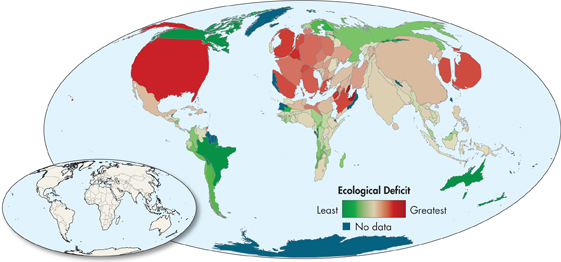Comparing Footprints Although calculating absolute footprints is difficult, ecological footprints can be useful for making comparisons among different populations, as shown in Figure 6–23.  According to one data set, the average American has an ecological footprint over four times larger than the global average. The per person use of resources in America is almost twice that in England, more than twice that in Japan, and almost six times that in China. To determine the ecological footprint of an entire country, researchers calculate the footprint for a typical citizen and then multiply that by the size of the population.
According to one data set, the average American has an ecological footprint over four times larger than the global average. The per person use of resources in America is almost twice that in England, more than twice that in Japan, and almost six times that in China. To determine the ecological footprint of an entire country, researchers calculate the footprint for a typical citizen and then multiply that by the size of the population.
 In Your Notebook How have you contributed to your ecological footprint today? Give at least ten examples.
In Your Notebook How have you contributed to your ecological footprint today? Give at least ten examples.

FIGURE 6–23 Relative Footprints This world map shows each country in proportion to its ecological footprint. The United States has an ecological footprint about twice the world's average. By contrast, the African nation of Zambia has a footprint a little over one -fourth the global average. Compare each country's “footprint” size to its actual size on the smaller map below.
Ecology in Action
 How can ecology guide us toward a sustainable future?
How can ecology guide us toward a sustainable future?
The future of the biosphere depends on our ecological footprints, global population growth, and technological development. Right now it's more common to hear stories of ecological challenges than successes. Given the size of those challenges, you might be tempted to give up, to feel that things are getting worse, and that there is nothing we can do about it. But ecological research, properly collected, analyzed, and applied, can help us make decisions that will produce profoundly positive effects on the human condition. The basic principles of ecology can guide us toward a sustainable future.  By (1) recognizing a problem in the environment, (2) researching that problem to determine its cause, and then (3) using scientific understanding to change our behavior, we can have a positive impact on the global environment. The following case studies illustrate the importance of the steps.
By (1) recognizing a problem in the environment, (2) researching that problem to determine its cause, and then (3) using scientific understanding to change our behavior, we can have a positive impact on the global environment. The following case studies illustrate the importance of the steps.
Table of Contents
- Formulas and Equations
- Applying Formulas and Equations
- Mean, Median, and Mode
- Estimation
- Using Measurements in Calculations
- Effects of Measurement Errors
- Accuracy
- Precision
- Comparing Accuracy and Precision
- Significant Figures
- Calculating With Significant Figures
- Scientific Notation
- Calculating With Scientific Notation
- Dimensional Analysis
- Applying Dimensional Analysis




